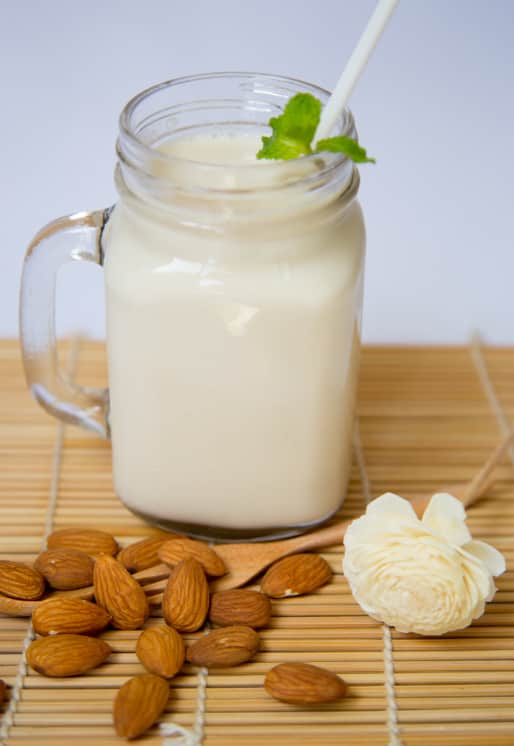Are you a fan of cereal? If you are, have you ever gone to eat your favorite bowl of cereal, reach inside your fridge for the milk, and realize the milk is gone?
Then you remember you were supposed to pick up more milk the night before to avoid this exact situation but forgot. But there, in the back of the fridge, is some almond milk.
Or maybe it’s nothing that dramatic. Maybe you’re just out of milk and all you have is almond milk or water to put on your cereal. In either case, you may be wondering if you can use almond milk in your cereal instead of regular milk.

The answer is yes, you can use almond milk with your cereal. Technically, you can use any liquid that isn’t poisonous in your cereal. That doesn’t mean you should.
However, when it comes to almond milk and cereal, almond milk is a perfectly adequate substitute for your normal dairy milk. Heck, if you use almond milk and like it, it may even become a replacement for your dairy milk.
And even if you’re not a complete fan of almond milk, it’s still a better fit for your cereal than, say, water or the coffee creamer on the other side of the fridge.
Now that you know you can use almond milk in your cereal and won’t be judged harshly for it, let’s take a look at why almond milk is good with cereal, some benefits almond milk brings to the table, and what type of cereals almond milk pairs well with.
What is Milk?

Before we get to further with almond milk, let’s get scientific and take a quick refresher course on what milk is. When we get into areas of all the “milk” products out there, it’s good to take a moment and remind ourselves where milk comes from.
That all out of the way, milk is a white liquid secreted by mammals through their mammary glands.
So, What is Almond Milk?

Almond milk, despite what its name implies, isn’t milk. Almonds are neither mammals nor do they have mammary glands. Almonds are the seeds of almond trees that are often enjoyed as snacks or ingredients in dishes and are an excellent source of vitamins and protein.
They are also plant-based products, so they are absolutely incapable of producing milk.
Which leads us back to the question asked in the above header: what is almond milk then?
Well, in short, it is pulverized and pureed almonds mixed with water and strained into the product we enjoy today known as almond milk. In addition, other ingredients are often added, such as sweeteners and thickeners, to give it a more “milk” like appearance and texture.
It’s a good alternative to dairy milk, especially for those with lactose intolerance or are vegans.
It’s called “milk” to highlight its alternative nature and use compared to actual milk.
Why Almond Milk Works With Cereal

Because almond milk is considered an alternative to dairy milk, and because of almond milk’s taste, texture, and consistency, it marries well with cereal. In fact, many people prefer to use almond milk with cereal, even if they prefer milk in other situations.
Why?
Well, almond milk has less fat, has fewer calories naturally, and is a good source of vitamins and minerals. It doesn’t have as much protein as dairy milk, but it is still an adequate source of protein. And again, it’s lactose-free. So, if you’re on a low to no-lactose diet, it’s probably the best alternative out there.
Other Commonly-Asked Questions
Is Almond Milk Creamier than Regular Milk?

No. Again, milk is a liquid secreted from the mammary glands of mammals. Although it consists of water, milk has a much higher fat content compared to almonds. Without fat, it’s hard to make anything creamy. To even make almond milk somewhat “creamy” takes some work by adding things like thickeners.
However, where almond milk may lack a “creamy” consistency, it makes up for it in flavor, texture, and appearance. As a result, it’s hard to distinguish almond milk from low-fat milk options, especially in cereals.
Does Almond Milk Taste “Nutty”?

Almond milk, being derived from the seed of almond trees and thus a nut, does have a nutty taste to it. However, the nutty taste is diluted by the water and other ingredients mixed with the almonds. As a result, a lot of the nutty flavor is lost and replaced with things like artificial flavoring or sweeteners.
Almond milk, though, will taste nuttier than regular milk if you do a side-by-side taste test.
Here’s an interesting thing to think about. Have you ever noticed a lot of cereals have nuts in them, especially almonds? So, in a way,a nutty flavor is exactly what you might want to be amplified with a cereal with nuts in it. Again, just something to think about.
What Types of Cereals Pair Well With Almond Milk?

Sometimes the most important question isn’t what the milk is made from, it’s what it tastes good with.
Here are some types of cereal that almond milk tastes good with:
- Cereals with almonds (of course)
- Cereals with added fruit or are fruit-flavored
- Whole grain and bran flakes cereals
- Rice cereal
- Chocolate-flavored cereals (especially with chocolate-flavored almond milk, because why not?)
Almond milk pairs well with all of the above and pretty much all dry cereals on the market. Just remember, if push comes to shove and all you have is almond milk in the fridge, you can rest easy knowing it will probably taste fine with your cereal, if not better than regular milk.
Is Almond Milk Low In Carbs?
Yes. But we’re also talking about using it in cereal. If you’re looking for a low-carb alternative to milk, then you also need a low-carb alternative to regular cereal.
Is Almond Milk Healthy?
Yesh, it’s healthy, but anyone with a nut allergy should be aware of their limitations.







